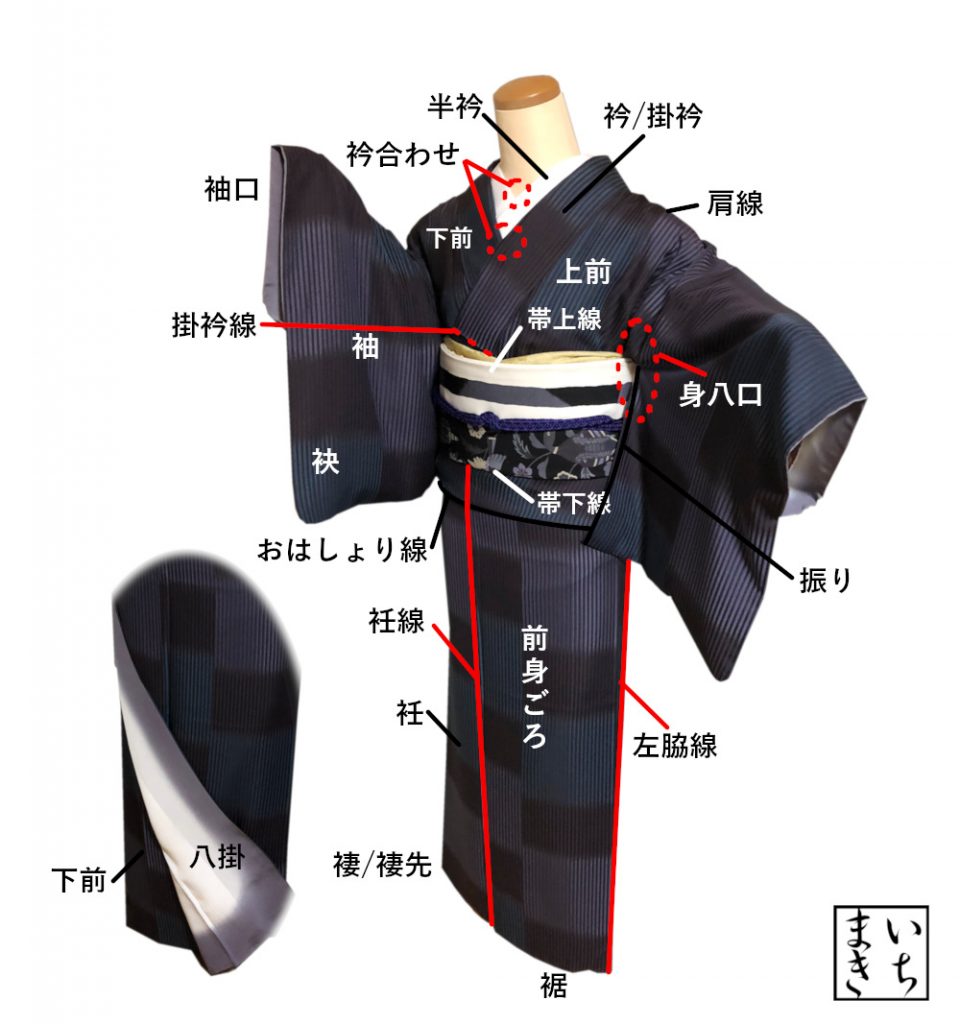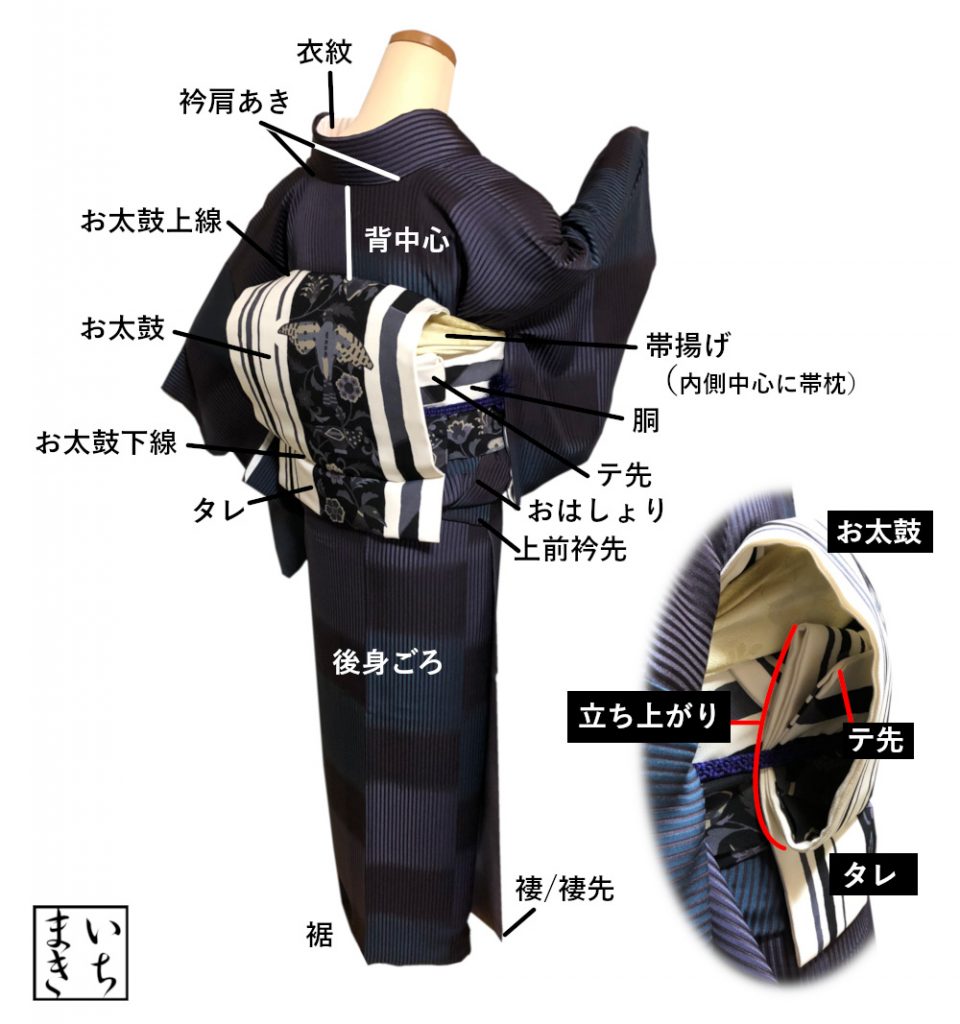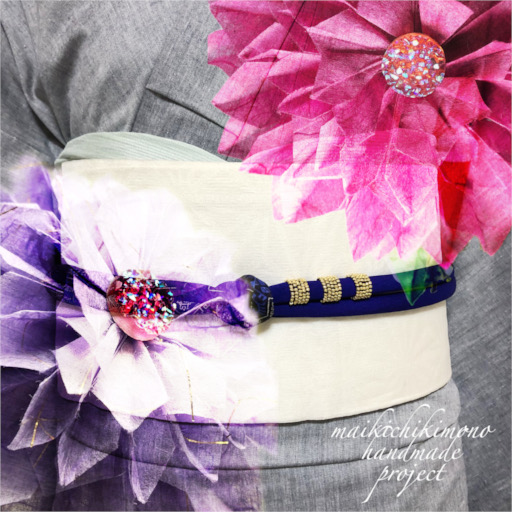着姿に関する用語です。
普段聞きなれない名前がたくさんありますね。
事前に覚えておくと着付けのお稽古がスムーズに。
でも、そんなに心配はいりません。進めていくうちに自然と覚えられます。
そうそう、「読み方が分からない!」それも解決しましょう。
まずは図をよく見てくださいね。
前姿
こちらは前から見たところ。

後姿
こちらは後ろから見たところ。

着姿の英語表現
日本語と英語で表しました。
着物は日本文化なので、外国人の方々に着せ付けをしたり着付けをお教えする時は、本当は固有の名詞を覚えて頂くのが好ましいです。
しかし、初めて聞く日本語は聞き取りにくいです。
(私たちも外国語に対して同様ですね^^)
なのでなるべく当てはまる英語を使い説明を加えます。
着物
衣紋(えもん):space at the nape
Make some space at the nape. / Put air in the space at the nape.
衣紋を開けます。(うなじの空間に空気を入れます。)
Opening space at the nape is one of the attractive points of kimono.
衣紋を開けることは、着物の魅力の一つです。
衿 : collar
半衿:”haneri” collar
A cloth that becomes the collar of underwear called “juban”
襦袢と呼ばれる下着の衿になる布地。
It is a detachable and decorative collar sewn on “juban”or an undergarment of kimono. You can change it as you like. There are many kinds of “haneri “collars for formal and informal events.
着物の下着である襦袢に縫い付けて使う、取り外しができる飾り衿です。あなたのお好みに替えられます。礼装や普段着用にたくさんの種類があります。
掛衿/共衿(かけえり/ともえり):top / first layer collar
“Kake-eri” or the first layer collar of kimono covers the main collar of kimono to prevent from getting dirty.
着物の一番上の衿である掛衿(共衿)は衿(地衿/本衿)を覆い、その衿が汚れるのを防ぎます。
掛衿線:horizontal line(s) on the collar / short line(s) on the collar
Match the horizontal lines on the collar to center the back seam.
背縫いを背中心に合わせるために掛衿線(衿の水平な線)を合わせます。
衿合わせの交点 : intersection of the collar / cross point of the collar
At the center front, align vertically the cross points of the collars of kimono and “juban”.
正面中央で、着物と襦袢の衿合わせを縦に揃えます。
衿先 : end(s) of the collar / collar end(s) / tip(s) of the collar
endは衿の端にある短い辺で、tipのイメージはと言うと衿角の方でしょうね。
衿肩あき:”eri-kata-aki”
The line where the collar connects the back of the kimono.
衿が着物の後ろ身頃とつながる縫い目。
*着付けでは方に近い方の衿肩あきの端(ちょうど力布があるところ)として言うことがあります。
背縫い(せぬい):back seam
背中心 : center back
前中心 : center front
肩線:shoulder line(s)
袖(そで):sleeve(s)
袖口:cuff(s)
振り(ふり):furi / opening(s) of the sleeve(s)
振りは振りですよね。強いて言えばopeningかな?
The openings make it easier to put on kimono.
Also, air goes through the openings and the sleeves are swinging beautifully.
It is one of the charms of kimono.
着易くするため開いています。また、開きから空気が入り(風が通り)袖が美しく揺れます。それは着物の魅力の一つとなっています。
身八口(みやつくち/ぐち):side hall(s) / opening(s)
It is easy to move even in a wide “obi” because it has “miyatsuguchi” openings.
身八口があるので、幅の広い帯でも動きやすいです。
前身ごろ(まえみごろ): front part(s) of kimono
The front part of kimono is divided into two sections. Both are called “mae-migoro” that cover the front body.
着物の前部は2つのセクションに分かれています。 どちらもを身体の表側を覆う「前身ごろ」と呼ばれています。
上前(うわまえ):a left front part including a bodice and skirt part
下前(したまえ):a right front part including a bodice and skirt part
左が上前、右が下前。不動の位置関係ですね。
Close the collar with the left front part up.
上前を上にして衿を閉じます。
Which side of kimono goes on top?
どちらが上になりますか?
The left does.
左側です。
後身ごろ(うしろみごろ):back part of kimono
”Ushiro-migoro” or the back part of kimono covers the back body.
「うしろみごろ」または着物の後ろ部分が体の後ろ側を覆います。
衽(おくみ):okumi / extended collar(s) attached to “maemigoro”, front part(s) of kimono
衽線(おくみせん):”okumi” line
衽は”okumi”と呼んでほしいですね。
Please stand straight with your feet together.
両足を閉じて立ってください。
Can you see the “okumi” line is on a split of the right “tabi”?
衽線は右足の足袋の指の割れ目にありますか?
脇線(わきせん):side seam line(s)
おはしょり:tuck / “ohashori” tuck
おはしょり線:tuck line(s)
“Ohashori” is a fold around the hips that is created by tucking excess fabric to make the kimono fit your body.
「おはしょり」とは、余分な生地を折り返して着物を身体にフィットさせることで生まれる、ヒップ周りの折り目です。
Straighten the “ohashori” tuck line.
おはしょり線をまっすぐにします。
褄先(つまさき):tip(s) of the hem / corner(s) of the front skirt (part)
前身ごろの裾の左右の先端が褄先です。
Lift the tip of the hem a little. Your lower body looks slim. So you look elegant.
褄先を少し上げます、裾が窄(つぼ)まり、裾まわりがすっきりします。そのため着姿がきれいに見えます。
裾 (すそ)/ 裾線:hem or the lower part of kimono / hemline or the bottom edge of kimono
“Suso-moyo” means patterns on the lower part of kimono.
”裾模様”とは着物の下部に施された模様のことです。
Set the hem line around the ankle when wearing “yukata”.
浴衣の裾はくるぶし辺りに合わせます。
八掛(はっかけ) : lining of the skirt part / bottom lining
帯
お太鼓:otaiko / a single layer obi shape
さすがにお太鼓はお太鼓でしょう。
“Ichiju-taiko” or a single layer obi shape is the most popular and basic shape in tying obi.
一重太鼓結びは最も一般的で基本的な帯結びです。
“Otaiko” derives from the shape of a bridge with an arch like the edge of a drum. It can usually be found in traditional Japanese gardens.
「太鼓」は太鼓の端のようなアーチのある橋の形に由来します。 通常、伝統的な日本庭園で見られます。
お太鼓上線:the upper line of “otaiko”
お太鼓下線:the bottom line of otaiko
帯の上線:the upper line of obi
帯の下線:the bottom line of obi
テ:half-folded part of “obi”
“Te” is a part of “obi” usually folded into half.
「テ」は、通常「半分」に折る「帯」の一部です。
テ先:the end of the half-folded part of “obi”
タレ:wide part of “obi”
タレ先:a tail / the end of “tare-saki”
立ち上がり:an inside flap
表現の誤りやより良い表現がある場合は随時更新しています。
他にも良い表現があったらお知らせください^^

